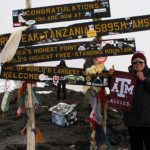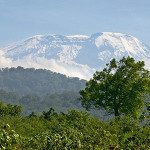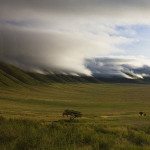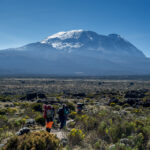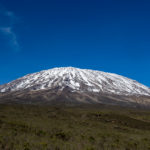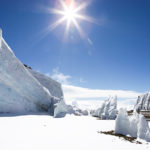Some of the first reports of “the white mountain” speak of them, and they’ve been immortalized by Ernest Hemingway. The snows of Kilimanjaro are almost as famous as the mountain itself.
But they won’t be around for long; estimates of when Kili’s famous glaciers will completely disappear vary, but most scientists agree that by 2060, the ice on Kili’s peak will live only in memory.
Global warming is almost certainly speeding up the glaciers’ demise, but it doesn’t appear to be the only cause of the melting. Between 1912 (the first year they were formally surveyed) and 2011, the glaciers shrunk by 85%, but even between 1889 and 1898, the dates of Hans Meyer’s first summit of Kilimanjaro and his second climb, they had retreated dramatically, leading Meyer to predict their complete disappearance within three decades.
 Images from Nasa’s Earth Observatory show the rapid retreat of the glaciers
Images from Nasa’s Earth Observatory show the rapid retreat of the glaciers
By Landsat 5 (NASA Earth Observatory Snow and Ice on Kilimanjaro) [Public domain or Public domain], via Wikimedia Commons
–
There are a few possible reasons for the glaciers’ disappearing act. Increasingly dry atmosphere in the surrounding region has changed weather patterns; drier atmosphere means fewer clouds overhead to protect the ice from the sun’s rays, as well as fewer of the snowstorms which help replenish the ice fields.
That atmospheric change might be an indirect result of global warming, but no matter why it’s happening, it’s almost certainly contributing to the glacial melt.
Another possible contributor is the nature of Kilimanjaro itself.
Though it’s no longer active, Kilimanjaro is a massive volcano, and while its last major eruption was hundreds of thousands of years ago, it showed activity as recently as 200 years back. Scientists believe that molten magma still courses through the mountain just 400 meters beneath Kibo’s summit crater; even though the peak is frigid, Kilimanjaro itself is hot.
And as more ice melts, the ice melt will speed up. Kili’s peaks are covered in obsidian, a black rock formed when lava cools rapidly. As more and more of that black rock is exposed, more light and heat will be trapped by the mountain surface, melting what ice remains more and more rapidly.
Whatever the cause (or causes), at this point it’s unlikely that the retreat of the glaciers can be stopped. So if you want to experience the mythic beauty of the snows of Kilimanjaro, make sure you get there soon!

